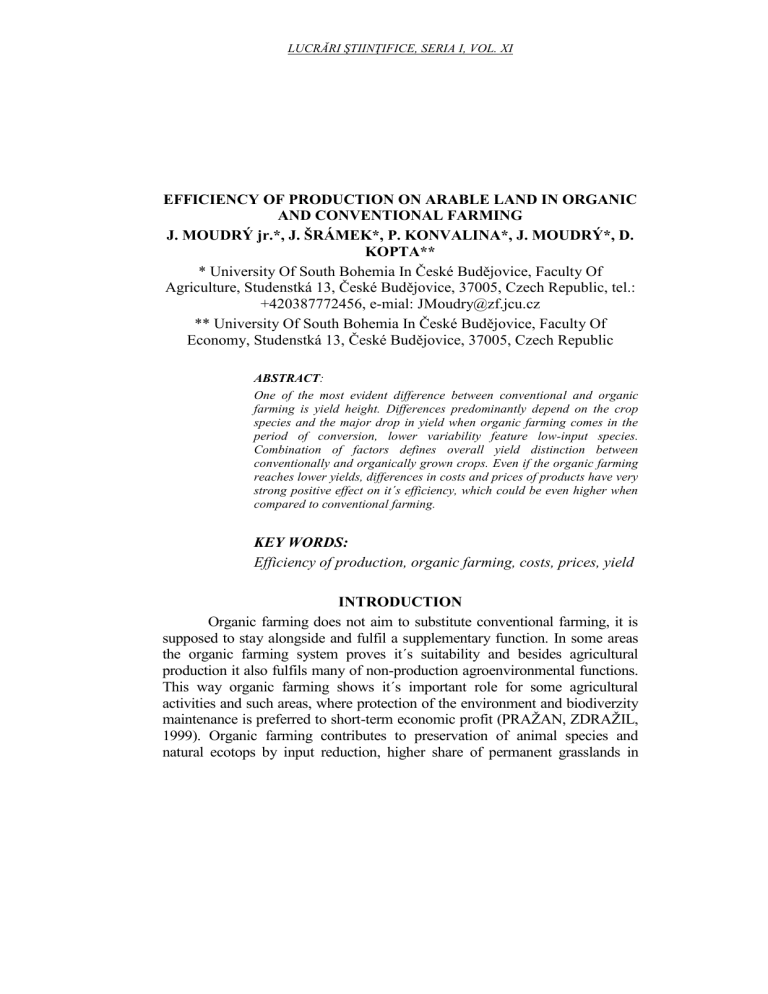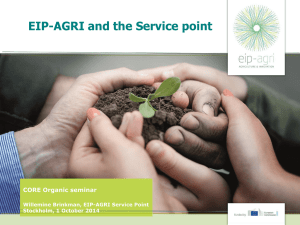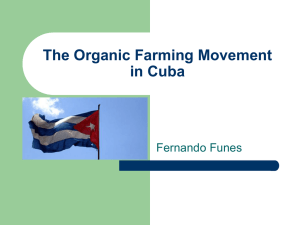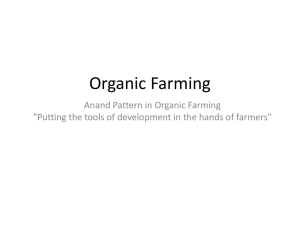EFFICIENCY OF PRODUCTION ON ARABLE LAND IN ORGANIC

LUCRĂRI ŞTIINŢIFICE, SERIA I, VOL. XI
EFFICIENCY OF PRODUCTION ON ARABLE LAND IN ORGANIC
AND CONVENTIONAL FARMING
J. MOUDRÝ jr.*, J. ŠRÁMEK*, P. KONVALINA*, J. MOUDRÝ*, D.
KOPTA**
* University Of South Bohemia In České Budějovice, Faculty Of
Agriculture, Studenstká 13, České Budějovice, 37005, Czech Republic, tel.:
+420387772456, e-mial: JMoudry@zf.jcu.cz
** University Of South Bohemia In České Budějovice, Faculty Of
Economy, Studenstká 13, České Budějovice, 37005, Czech Republic
ABSTRACT:
One of the most evident difference between conventional and organic farming is yield height. Differences predominantly depend on the crop species and the major drop in yield when organic farming comes in the period of conversion, lower variability feature low-input species.
Combination of factors defines overall yield distinction between conventionally and organically grown crops. Even if the organic farming reaches lower yields, differences in costs and prices of products have very strong positive effect on it´s efficiency, which could be even higher when compared to conventional farming.
KEY WORDS:
Efficiency of production, organic farming, costs, prices, yield
INTRODUCTION
Organic farming does not aim to substitute conventional farming, it is supposed to stay alongside and fulfil a supplementary function. In some areas the organic farming system proves it´s suitability and besides agricultural production it also fulfils many of non-production agroenvironmental functions.
This way organic farming shows it´s important role for some agricultural activities and such areas, where protection of the environment and biodiverzity maintenance is preferred to short-term economic profit (PRAŽAN, ZDRAŽIL,
1999). Organic farming contributes to preservation of animal species and natural ecotops by input reduction, higher share of permanent grasslands in
LUCRĂRI ŞTIINŢIFICE, SERIA I, VOL. XI agricultural land and wide use of indigenous plants and plant varieties
(SAMSONOVÁ, ŠARAPATKA, URBAN, 2005).
Unfortunately this contribution by organic farmers, who has to be seen as a landscape manager (ŠARAPATKA, NIGGLI et. al.
2008), has not directly been quoted. Compared to conventionally farming systems organic farmers are in many aspects limited due to their environmentally friendly behaviour (lower yields, legislative restrictions, partially higher costs per own production unit as well). Such environmentally friendly altitude has to be quoted for example by means of grants especially in current situation when actual economic system one-sidedly prefers such behaviour that farmers aim to realize a profit before all, even though such activity could lead to losses for the society when long-term prospects are considered
(ŠARAPATKA, DLOUHÝ, 1998). Successful development of competitive and environmentally friendly agricultural production in less favourable areas depends on necessary state support focused on extensive agricultural production, landscape maintenance and further environmentally oriented services (STŘELEČEK, KOLLÁR, LOSOSOVÁ, 2003) .
There is necessary to implement such methods of productivity assessment that can help to quantify the effects of production increase on the environment and so-called environmental accounting which will help to evaluate sustainable benefit and take into account costs associated with corrections and compensations for damages and sources degradation
(VIRMANI, SINGH, 1997), whereas complicated evaluation of nonproduction environmental function must not be the reason for their ignorance or arbitrary replaced by zero (HAMPICKE, LIPTERSKY,
WICHTMANN, 2005).
Although organic farmers have such means that can help them to reach almost the same economic efficiency as conventional farmers (for example. VRKOČ et. al.
(1996) states, that cropping structure is more important than manuring, plant varieties choice and other minor factors of economic efficiency), without appropriate support they cannot be equally efficient from the economic point of view due to different limitations of both systems. However, by taking suitable advantage of grant programmes and differences in price between conventional production and bioproducts, organic farmers can reach the same or even higher efficiency as conventional farmers.
LUCRĂRI ŞTIINŢIFICE, SERIA I, VOL. XI
MATERIAL AND METHODS
The analyses of agricultural production efficiency was carried out using data of the file of 57 companies from South and West Bohemia, comprising 33 conventional and 24 organic farms from production and submontane regions ( elevation 350 - 1100 m above see level). Data collection was provided by means of questionnaire survey and direct interviews in site.
The analyses was based on provided yields of plants and evaluation of technological processes was done. For further analyses were chosen potatoes and wheat, additional data was calculated for rye and triticale. For comparison the variable and technological costs of chosen crops within the organic and conventional farming system were calculated using the Costs limits for agricultural production technologies. Cost item were taken over and modified according to KAVKA (2006).
RESULTS
Agricultural production in organic and conventional farming systems largely differs based on different altitude of both systems and different legislative restrictions. The differences are evident for costs of particular crops, yields and products prices as well. These differences for particular crops vary which can help to define their suitability for organic farming systems.
Costs
Organic farming features different relations between costs and revenues when compared to conventional farming. Costs per production unit also vary, these are usually higher within organic farming and costs per area unit are usually lower. Within organic farming costs per area unit reach 10-
25% lower values in general. The most evident decrease falls on variable cost, where it can make 40% fall. 1). On a case-by-case basis these numbers vary due to the ability of a company to minimize production investments,
LUCRĂRI ŞTIINŢIFICE, SERIA I, VOL. XI exploit machinery potential, reduce labour costs and overcome the depression after conventional-to-organic transformation.
Obr. 1 - Differences in cost structure within OF and CF - variable costs
Obr. 2 – Costs for wheat grown in conventional and organic farming
Costs for wheat growing in organic (OF) and conventional (CF) farming
20000
15000
10000
5000
0
2001 2002 2003 2004 2005 2006 2007
Year costs (CZK) OF costs (CZK) CF
LUCRĂRI ŞTIINŢIFICE, SERIA I, VOL. XI
Between years 2001 - 2007, monitored in selective file of farmers and wheat production, costs gradually rose but there was evident difference between organic and conventional production (fig. 2).Within organic farming wheat production costs are still lower but the difference decreases.
If the structure of costs is studied in detail we can find further distinctions between conventional and organic farming. According to figure 1., for organic wheat production there fall costs on manuring and vegetation season treatment which results from chemical agents use limitations and on the other hand this has to be compensated by more frequent need of mechanical operations during presowing and sowing period. Costs during harvesting, post-harvesting and storage slightly rise as well.
Yields
In general yields per area unit are lower within organic farming. In figure 3 there is obvious that organic wheat yields reach about 3/4 values compared to conventional production. Production of other cereal crops reaches similar numbers ( rye - 63%, triticale - 75%, oat - 69%, potatoes
62%). However, lower yields are compensated by higher prices of bioproducts.
Fig. 3 – Yield of wheat in organic and conventional farming
Yield of wheat in organic (OF) and conventional
(CF) farming
4
3
2
1
0
7
6
5
2001 2002 2003 2004 2005 2006 2007
Year yield (t/ha) OF yield (t/ha) CF
LUCRĂRI ŞTIINŢIFICE, SERIA I, VOL. XI
Price relations
Main factors of competitiveness of organic farming are prices differences and grant supports. Even here we find differences between particular crops. Bio-quality of production increased price of wheat by 40%,
21% by triticale and 12% by oat. Prices in both organic and conventional farming rise by approximately same share which leads to their difference rise in long-term point of view. This is shown on wheat production during
2001 - 2007 (fig. 4).
Fig. 4 – Prices of wheat in organic and conventional farming
Prices of wheat in organic (OF) and conventional
(CF) farming
10000
8000
6000
4000
2000 price (CZK) OF price (CZK) CF
0
2001 2002 2003 2004 2005 2006 2007
Year
Crops production efficiency
Yield, costs and price relations differ with dependence on particular crops. This enables an effective production even in cases when price differences cannot counterbalance lower yields reached within organic farming. However it is not possible to reach comparable or even higher economic effect using combinations of costs, yields and prices of products only without further support, e. c. grants. According to tab. 1 there is
LUCRĂRI ŞTIINŢIFICE, SERIA I, VOL. XI obvious that organic potatoes production reached about 70% efficiency of conventional farming in marketing year 2007/2008. After taking into account the differences, gains per one ha reached 2354,- EUR within conventional farming and 1648,- EUR within organic farming. By contrast gains of conventional wheat production reached only 83,4% efficiency when compared to organic wheat production. (366,- EUR per ha within conventional and 439,- EUR per ha within organic farming).
Tab. 1 - Potatoes production efficiency within organic farming - prices, costs, yields
Marketing year
Prices
[CZK.ha
-1 ]
Yields
[t.ha
-1 ]
Costs
[CZK.ha
-1 ]
2001/
2002
2002/
2003
2003/
2004
CF 3079 3307 3703
OF 4805 5504 5785
2004/
2005
2978
4918
2005/
2006
3050
4778
2006/
2007
2007/
2008
6520 5510
8500 7182
CF 20,88 23,57 19,35 23,57 28,05 21,70 25,69
OF 11,33 12,38 11,47 14,60 17,39 11,93 14,60
CF 70835 72471 63510 70472 69520 71398 75613
OF 67975 57122 57049 53713 51340 56890 58720
Final effect of organic crops production is increased by grants (SAPS
+ TOP–UP). Grants for organic farmers are higher due to the possibility to take advantage of some grant titles that conventional farmers cannot apply for (Agroenvironmental programmes – Organic Farming). Using these grant programmes organic farmers are provided about 125% financial means per ha of arable land compared to conventional farmers. Taking into account that organic farming on arable land is in its initial phase very labour and organization-intensive the support is fair.
CONCLUSION
The share of organic production has been still rising. This way organic farming has been getting in such a situation that it should not be dependant on grant in current range, however it´s future support is necessary. According to the analyses, using suitable combination of costs,
LUCRĂRI ŞTIINŢIFICE, SERIA I, VOL. XI yields and bioproduct prices combined together with appropriate crop choice, organic farming can be in competition with conventional farming as far as the economic efficiency is considered.
ACKNOWLEDGEMENT
This work was supported by the grant NAZV QG 50034 and MSM
6007665806.
BIBLIOGRAPHY
HAMPICKE, U., LIPTERSKY, B., WICHTMAN, W. (2005):
Ackerlandschaften – Nachhaltigkeit und Naturschutz auf ertragsschwachen
Standorten, Springer-Verlag, Berlin Heidelberg, 311 p.
KAVKA, M., et. al.
(2006): Normativy zemědělských výrobních technologií. Praha: ÚZPI Praha, 376 p.
PRAŽAN, J., ZDRAŽIL, V. (1999): Kodex správné zemědělské praxe před vstupem do EU, studie VÚZE a UAE Praha, 43 p.
SAMSONOVÁ, PAVLÍNA, ŠARAPATKA, B., URBAN, J. (2005): Přínos ekologického zemědělství pro kvalitu podzemních a povrchových vod. Pro-
Bio Šumperk a Bioinstitut O.P.S. Olomouc, 43 p.
STŘELEČEK, F.; KOLLÁR, P.; LOSOSOVÁ, JANA (2003): Vliv dotací na hospodářský výsledek zemědělských podniků v produkčních a marginálních oblastech. Agricultural economics : zemědělská ekonomika.
1(6), 10., p. 251-260
ŠARAPATKA, B., DLOUHÝ, J. (1998): Je cena potravin odrazem skutečných nákladů na jejich produkci? Zemědělská ekonomika, 44, (11), p.
507 – 510
ŠARAPATKA, B., NIGGLI, U., et. al . (2008): Zemědělství a krajina – cesty k vzájemnému souladu, Univerzita Palackého v Olomouci, Olomouc, 271 p.
VIRMANI, S. M., SINGH, G. B.(1997): Sustainable agriculture: biophysical and agroecological indicators. Proc. Third Agric. Sci. Congress,
PAU Ludhiana, Indie, p. 57 – 75
VRKOČ, F., ŠIMON, J., VACH, M., CAGAŠ, B. (1996): Restrukturalizace a extenzifikace rostlinné výroby. Metodika ÚZPI č. 3, p. 25-32









